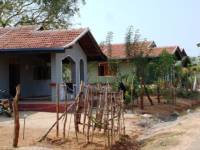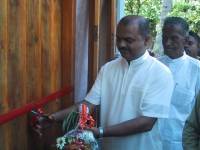Background and Objectives
Background

The tsunami that hit Sri Lanka on 26 December, 2004 was the worst natural calamity in the history of this island-nation. It ravaged the southern coast - the most densely populated and urbanized part of the country -- and its impact was even more severe in the conflict-scarred North East where people had already suffered displacement for over 20 years. More than 70,000 houses have been reported as completely destroyed, with a further 30,000 damaged. Most of the community infrastructure was destroyed. UN-HABITAT's role covered a wide range of activities from advocacy to policy advice, coordination and building partnerships, and the implementation of housing recovery and reconstruction projects. Commencing with its response to the UN's Flash appeal, UN-HABITAT's post-tsunami experience in Sri Lanka also demonstrates its ability to rapidly and effectively respond to a disaster recovery situation.
All projects follow the same community-based approach to housing rehabilitation and reconstruction. They bring housing and settlement needs to the forefront, advocate community-driven reconstruction, demonstrate good practices, and support government institutions to mobilize resources by facilitating innovative partnerships. The advantage of engaging the affected people in the decision-making process and implementation of the projects is that it helps them to overcome the traumas of the tsunami and restores their dignity and confidence.
The Government of Sri Lanka had adopted two approaches to housing reconstruction, one a so-called Donor Driven process (contractor-built housing), the other a Home Owner Driven (HOD) process. UN-HABITAT can take considerable credit for being one of the main advocates of the HOD process. Based on its experience with the People's Process, UN-HABITAT expanded the HOD to a more holistic approach to recovery and reconstruction.
UN-HABITAT's community centred approach advocates that while affected families are vulnerable on their own, their ability to cope through mutual support is enhanced as part of an organized group. As a result an organized community in a post construction situation is able to establish linkages for livelihood activities undertake care and maintenance of community facilities and establish links with Local Authorities for mutual benefit, ensuring the long term sustainability of the settlements. It quickly became evident that the People's Process was much more effective than the contractor approach.
Objectives
The objective of the Programme is to assist communities and families rebuild their settlements and housing with the assistance of the grant from the Government and the top-up grants from the projects in an integrated community based approach rather than leaving individual families to fend for themselves.
More specifically, the objectives include the following:
-To enable people to rebuild their social capital through the organisation of representative bodies with the capacity to take decisions regarding their own rebuilding process and establish their community level governance structures; (social capital)
-To enable the target communities to plan and rebuild essential damaged and destroyed basic facilities according to their priorities (physical infrastructure)
-To facilitate families to resolve their land disputes enabling them to access the reconstruction grants (land tenure)
-To assist families to complete applications and open bank accounts; (access to banking)
-To assist the families build their housing so that they can restart functioning as a normal stable family freeing them from the instability of life in temporary housing and camps; (family housing)
-To build the capacity of Sri Lanka Red Cross Branch (PNS/IFRC) to support disaster affected communities rebuilding process (building a critical mass of support at national level)
-To assist the families establish their own banking system through a savings and credit cooperative to ensure economic stability and opportunities for entrepreneurship; (family economic stability)
-To help create employment from the investment of the rebuilding process as a way of contributing to the recovery of the local economy; (work opportunities)
-To make the community responsible for the reconstruction process as a way of rebuilding shattered communities and imparting self-reliance; (self reliance)
-To link families to other services like health and education (family welfare)
-To establish a self managed sustainable community with social facilities and livelihood opportunities. (community governance)
Activities
The main activities of the post-tsunami projects still operational in 2009 include:
-Enable traumatized communities, in particular women and children, rebuild their social capital through the organization of representatives bodies (Community Development Councils) with the capacity to take decisions regarding their own rebuilding process;
-Introduce a people-centred approach to housing and community infrastructure reconstruction through community mobilisation, community action planning and preparing work plans;
-People involved in the implementation of the recovery projects through community contracts.
-Support the targeted communities to rebuild their homes destroyed by the tsunami, allowing them to restart functioning as normal communities;
-Help create employment from the investment in the rebuilding process as a way of contributing to the recovery of the local economy;
-Promote people's engagement in the reconstruction as a way of rebuilding shattered communities and imparting self-reliance.
Results (2009)
* The most significant achievement of UN-HABITAT was the community development aspect of the People's Process;
* Through the establishment of Community Development Councils and using Community Action Planning processes, UN-HABITAT proved within one year after the tsunami that the People's Process to housing recovery and reconstruction was highly successful;
* This helped the agency in attracting donor funding for the implementation of a large number housing projects;
* These projects were not just providing houses, but an integrated approach in supporting communities to rebuild their lives and social capital;
* By the end of 2009, UN-HABITAT completed some 10,600 houses in sustainable communities, making UN-HABITAT the agency facilitating the rebuilding of the largest number of houses in post-tsunami Sri Lanka.
Photo Gallery
Development Partners / Partners
Development Partners: City of Munich, BASF, IFRC (International Federation of Red Cross and Red Crescent), IFAD, Salvation Army, Norwegian People's Aid, Overseas NGO
Partners: Ministry of Nation Building, Ministry of Urban Development and Water Supply, Ministry of Housing, Provincial Governments, Local Authorities
- Catalytic Support to Peacebuilding in Sri Lanka
- Preparation of the Resettlement Plan (RP) for Households Affected by the Rehabilitation of the Kelani Valley (KV) Railway Line in Sri Lanka (Phase I)
- Emergency Shelter Relief for Flood and Landslide Affected Households in Kalutara and Galle Districts of Sri Lanka
- The State of Sri Lankan Cities Report
- Human Development Initiative through Empowerment and Settlement Improvement in the Plantation Settlements in Sri Lanka
- Indian Housing Project in Central and Uva Provinces
- Emergency Shelter Relief for Flood Affected Families in Colombo and Gampaha Districts in Western Province, Sri Lanka (Completed)
- Sustainable Resettlement through Community-Driven Improvement of the Learning Environment in Mannar District, Sri Lanka
- Support My School: Supporting Schools in Northern Sri Lanka with Access to Water and Sanitation Facilities (Completed)
- Project for Rehabilitation of Community Infrastructure, Improvement of Livelihoods and Empowerment of Women in the Northern and Eastern Provinces (RCI) (Completed)
- Rainwater Harvesting in a Water Scarce Small Village in Northern Sri Lanka (Completed)
- Climate Resilient Action Plans for Coastal Urban Areas (Completed)
- Disaster Resilient City Development Strategies for Sri Lankan Cities (Completed)
- Disaster Resilient City Development Strategies for Four Cities in the Northern and Eastern Provinces of Sri Lanka (Phase II) (Completed)
- Rehabilitation of Community Infrastructure and Facilities in the Conflict Affected Areas in Northern Province of Sri Lanka (Completed)
- Improving Living Conditions in Returnee Areas of Sri Lanka through Housing (Completed)
- Indian Housing Project (Completed)
- Support to Conflict Affected People through Housing (Completed)
- Shelter Support to Conflict-affected IDPs in the North of Sri Lanka (Completed)
- Jaffna Tsunami Recovery and Reconstruction Project (Completed)
- Community Recovery and Reconstruction Partnership to Support the People's Process of Rebuilding (Completed)
- Reconstruction of Fish Market in Galle (Completed)
- Rebuilding Community Infrastructure and Shelter in Tsunami-Affected Areas (Completed)
- Lunawa Lake Environment Improvement and Community Development Project (Completed)
- Pro-Poor Partnerships for Participatory Settlement Upgrading (Completed)
- Early Recovery Shelter for IDPs in Batticaloa (Completed)
- Support to the Urbanization Framework
- Post Disaster Housing Coordination Project (Completed)
- Sustainable Cities Programme (Completed)
- Urban Governance Support Project (UGSP) (Completed)
- Rebuilding Communities in North East Sri Lanka (Completed)
- Urban Poverty Reduction Strategy - Colombo (Completed)








































